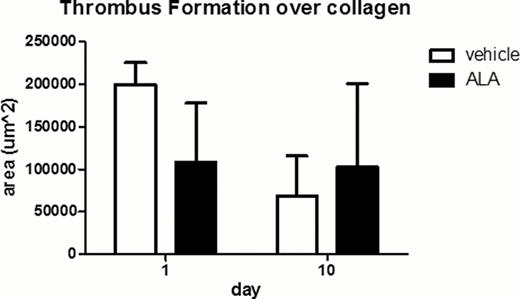Abstract
Abstract 3433
Omega-3 fatty acids (W3-FA) have been shown to be cardioprotective by reducing plasmatic triglycerides, atherosclerosis, arrhythmias, inflammation, and thrombosis. We have previously demonstrated that the plant-derived W3-FA a-linolenic acid (ALA) can achieve similar effects as the marine-derived EPA and DHA; it reduced platelet activation and aggregation, atherosclerosis and thrombosis in mouse models. In particular, ALA increased platelet survival by reducing their clearance, thus resulting in an increased platelet count.
To translate this finding to transfusion medicine, we hypothesized that the addition of ALA to platelet apheresis units a) could reduce platelet baseline activation during storage and b) result in a better function/activatability over 5–10 days of storage.
In this pilot study, 4 platelet apheresis units from 2 healthy volunteers were collected according to routine blood bank standards and stored under typical conditions at 22°C on a rocker for 10 days. The units were supplemented with 30 uM ALA (a concentration which can be achieved by dietary intake) or vehicle (ethanol). Samples were analyzed daily over 10 days for impedance aggregometry, thrombin generation, thrombus formation on collagen and adhesion to VWF under high shear conditions (2500 s−1). Receptor expression/activation/cleavage was determined by flow cytometry (GPIb, P-selectin, activated a2bb3 integrin, Annexin V binding) and loss of mitochondrial membrane potential by JC-1 staining.
After 10 days of storage, platelets from ALA-treated bags showed a better activatability compared to vehicle-treated bags. Thrombus formation on collagen in the flow chamber at d10 was higher for ALA-treated platelets (covered area: 102.779 um2 vs 68.729 um2) as well as the adhesion to VWF (platelet-covered area: 2072,2 um2 vs 427,3 um2). Thrombin generation (as measured by CAT assay) was also higher for ALA-treated samples on d10 (ETP: 15.5 nm thrombin/min vs <2 nm thrombin/min). Thrombin-induced aggregation was higher for the ALA-treated samples (AUC: 17.1±10.4 vs 3.65±0.21 with 0.25 U/ml thrombin; 59±51 vs 15.35±10.5 with 0.5 U/ml thrombin). ALA reduced GPIb cleavage from the platelet membrane (decrease of surface exposed GPIb: d1=100%, d10= 69±10% vs 63±7%). On the other hand, ALA reduced the spontaneous expression of the active conformation of a2bb3 integrin (1.18 vs 1.94 fold) and the P-selectin expression (0.9 vs 1.20 fold), while the thrombin-induced activatability of these receptors was preserved. ALA also reduced the platelet aggregation in response to collagen and thrombin on d1.
The addition of ALA to single donor platelet apheresis units at a concentration which is nutritionally achievable results in preserved platelet activatability and function over time, while it reduces baseline activation under typical storage conditions. Both endpoints appear favorable in transfusion medicine and encourage further evaluation.
No relevant conflicts of interest to declare.
Author notes
Asterisk with author names denotes non-ASH members.


This feature is available to Subscribers Only
Sign In or Create an Account Close Modal